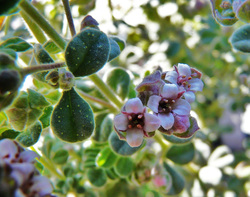Three Threatened Plants
1. The Bomaderry Zieria – a rare and curious plant!
In 1883 when William Baeuerlen collected a specimen from a Zieria shrub growing near Bomaderry Creek, he would have had no idea that this previously unknown species would be named after him and of the interest his finding would inspire over a century later. Zierias are related to boronias and, with their highly aromatic leaves, it may be of no surprise to learn that they are in the citrus family. Classified as endangered at both national and state levels, the Bomaderry Zieria (Zieria baeuerlenii) is totally endemic to the Bomaderry Creek Bushland where it was rediscovered in 1987 after being classified as ‘presumed extinct’. It was originally thought to be a hybrid of two other closely related Zieria species, but this was proved to be incorrect when environmental scientist Terry Barratt completed 2-year post-graduate work on the species in 1999. Many important conservation biology questions were examined by Terry such as: how does the species propagate, does it set seed, is it a distinct species or is it a hybrid, why is it not found elsewhere and what are the threats to its survival? Some answers were clear: it does not set seed; it propagates mainly by suckering and occasionally by layering; it is a distinct species and the population consists of 22 clonal groups. Subsequent work by Terry, under contract to the National Parks & Wildlife Service, revealed evidence that drought was a serious threat to the species and that an occasional fire may be beneficial. Direct human threats to the species are vandalism and, of course, a proposed road through its habitat. |

2. The Nowra Mallee (Eucalyptus langleyi)
This species is a member of that unique group of eucalypts that do not develop a single trunk but grow as a series of stems from a woody rootstock called a lignotuber. The Nowra Mallee, as the name suggests, is found only in the Nowra district. It is listed as ‘vulnerable’ at both the national and state level and the population in the Bushland (which is the only site north of the Shoalhaven River) has a special classification as a ‘threatened population’. It occurs in a small number of sites around the periphery of the Narang Picnic Area, Bomaderry. Due to concerns about the decline in the size of this population and the risk of ongoing decline due to present and planned human activity, Terry Barratt carried out a study of the population in 2009. He established that a long history of sandstone quarrying, development of a picnic area, access roads and walking tracks within the species’ habitat, plus the inevitable weed infestations that accompanied all of this disturbance, had undoubtedly caused the main decline of the population. Terry was also able to establish that the severe drought conditions during the early 2000s, exacerbated by human induced drainage changes, had contributed to a decline of the species. Add to this the threat of Council’s proposed North Nowra link road which would destroy two plants out of a very small population of twenty plants (a 10% loss), the NSW Scientific Committee declared this location of the species as an ‘endangered population’. NEXT |
